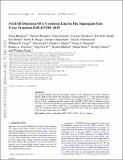NuSTAR detection of a cyclotron line in the supergiant fast X-ray transient IGR J17544-2619
Author(s)
Bhalerao, Varun; Romano, Patrizia; Tomsick, John; Natalucci, Lorenzo; Smith, David M.; Bellm, Eric; Boggs, Steven E.; Chakrabarty, Deepto; Christensen, Finn E.; Craig, William W.; Fuerst, Felix; Hailey, Charles J.; Harrison, Fiona A.; Krivonos, Roman A.; Lu, Ting-Ni; Madsen, Kristin K.; Stern, Daniel; Younes, George; Zhang, William; ... Show more Show less
DownloadChakrabarty_NuSTAR detection.pdf (1.694Mb)
OPEN_ACCESS_POLICY
Open Access Policy
Creative Commons Attribution-Noncommercial-Share Alike
Terms of use
Metadata
Show full item recordAbstract
We present NuSTAR spectral and timing studies of the supergiant fast X-ray transient (SFXT) IGR J17544−2619. The spectrum is well described by an ~1 keV blackbody and a hard continuum component, as expected from an accreting X-ray pulsar. We detect a cyclotron line at 17 keV, confirming that the compact object in IGR J17544−2619 is indeed a neutron star. This is the first measurement of the magnetic field in an SFXT. The inferred magnetic field strength, B = (1.45 ± 0.03) × 10[superscript 12]G (1 + z) is typical of neutron stars in X-ray binaries, and rules out a magnetar nature for the compact object. We do not find any significant pulsations in the source on time-scales of 1–2000 s.
Date issued
2015-01Department
Massachusetts Institute of Technology. Department of PhysicsJournal
Monthly Notices of the Royal Astronomical Society
Publisher
Oxford University Press
Citation
Bhalerao, V., P. Romano, J. Tomsick, L. Natalucci, D. M. Smith, E. Bellm, S. E. Boggs, et al. “NuSTAR Detection of a Cyclotron Line in the Supergiant Fast X-Ray Transient IGR J17544-2619.” Monthly Notices of the Royal Astronomical Society 447, no. 3 (January 5, 2015): 2274–2281.
Version: Author's final manuscript
ISSN
0035-8711
1365-2966